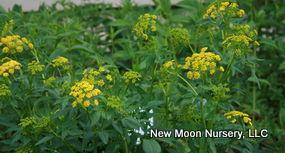Printed at http://www.newmoonnursery.com/index.cfm/
Zizia aureus
Golden Alexander's
Native to North America
FIRST IMPRESSIONS: Zizia aurea is a 1-3’ tall upright perennial wildflower with glossy compound basal leaves. From late spring to early summer flowering stems elongate bearing showy umbrella shaped clusters of small yellow florets. Scads of beneficial pollinators flock to the blooms. This golden beauty thrives in sunny sites with moist loamy soil.
HABITAT & HARDINESS: Zizia aurea occurs in eastern North America west to Manitoba, Montana, South Dakota, Nebraska, Kansas, Oklahoma and Texas.
This species is indigenous to disturbed and high quality habitats including moist or wet Blackland prairies, oak savannas, limestone glades, thinly wooded bluffs, moist meadows, alluvial woods, swamp forests, open moist to mesic woods, thickets, fields and powerline right of ways.
Plants are hardy from USDA Zones 3-9.
PLANT DESCRIPTION: Zizia aurea is an erect perennial with coarse fibrous roots and occasional lateral stems.
Plants have shiny pinnately compound basal foliage with 3-5 toothed leaflets. The leaflets are about 3” long with long petioles and variable shape (lanceolate, cordate, oblong or lobed).
Several smooth shiny stems with light green vertical lines rise from the basal rosettes.
The stems bear alternate compound leaves with short petioles. They are topped by rounded or flat topped compound umbels of tiny yellow florets.
Each umbel averages 2-3” across and can contain as many as 250 florets that are about 1/8” wide.
Blooming begins in late spring and continues for about a month. The florets mature into small oblong ribbed seed.
Plants grow 1-3’ tall with a 1-2’ spread.
CULTURAL & MAINTENANCE NEEDS: Zizia aurea flourishes in sun or part sun with moist loamy soil. Plants tolerate clay loam, rocky or gravelly soil, alkaline pH and controlled burns.
This species is easy to grow but is considered to be a short lived perennial that persists by re-seeding.
LANDSCAPE USES: This is a good choice for a Wildlife Garden or sunny Meadow. Plants are also used as Butterfly Nectar Plants, Butterfly Host Plants or as part of a Grouping or Mass Planting. Zizia aurea has Showy Blooms and is appropriate for Cottage Gardens, Cut Flower Gardens, Low Maintenance Plantings, Prairie Gardens, Rain Gardens and Perennial Borders.
COMPANION & UNDERSTUDY PLANTS: Try pairing Zizia aurea with Asclepias tuberosa, Bouteloua curtipendula, Carex bicknellii, Monarda fistulosa, Rudbeckia hirta, Schizachyrium scoparium, Sporobolus heterolepis or Sorghastrum nutans.
TRIVIA: Zizia aurea belongs to the Apiaceae or Umbelliferae (Carrot Family). The generic name is in honor of German botanist Johann Baptist Ziz (1779–1829). The specific epithet aurea means “golden”.
Zizia spp. are commonly called Alexanders in reference to a medicinal herb species (Smyrnium olusatrum) used by the ancient Romans. These herbs were also in the Carrot Family and were called Alexanders because they were first found near the city of Alexandria.
Many species of small short tongued bees, pollinating flies, butterflies, beetles, long tongued bees and true bugs seek nectar and pollen from the flowers. Black swallowtail butterfly and Ozark swallowtail butterfly caterpillars feed on the foliage.
Zizia aurea differs from the closely related Z. aptera because it has compound basal leaves and a preference for wetter sites. Z. aptera has simple basal leaves and a preference for drier sites.
Height:
1-3 ftSpread:
1-2 ftSpacing:
18-24 inUSDA Hardiness Zone:
3-9Bloom Color:
YellowZizia aureus Characteristics
Attracts Wildlife
- Butterflies
- Pollinators
Attributes
- Drought Tolerant
- Dried Flower
- Rain Garden
- Cut Flower
- Clay Soil
- Bog
- Rock Garden
- Naturalizing
Exposure
- Full Sun to Partial Shade
Flowering Months
- June
- May
Foliage Color
- Green
Salt Tolerance
- Medium
Season of Interest (Foliage)
- Summer
- Spring
- Winter
Soil Moisture Preference
- Moist to Wet
Interesting Notes:
For more information on this plant, visit the USDA PLANTS Database: http://plants.usda.gov/java/profile?symbol=ZIAU

